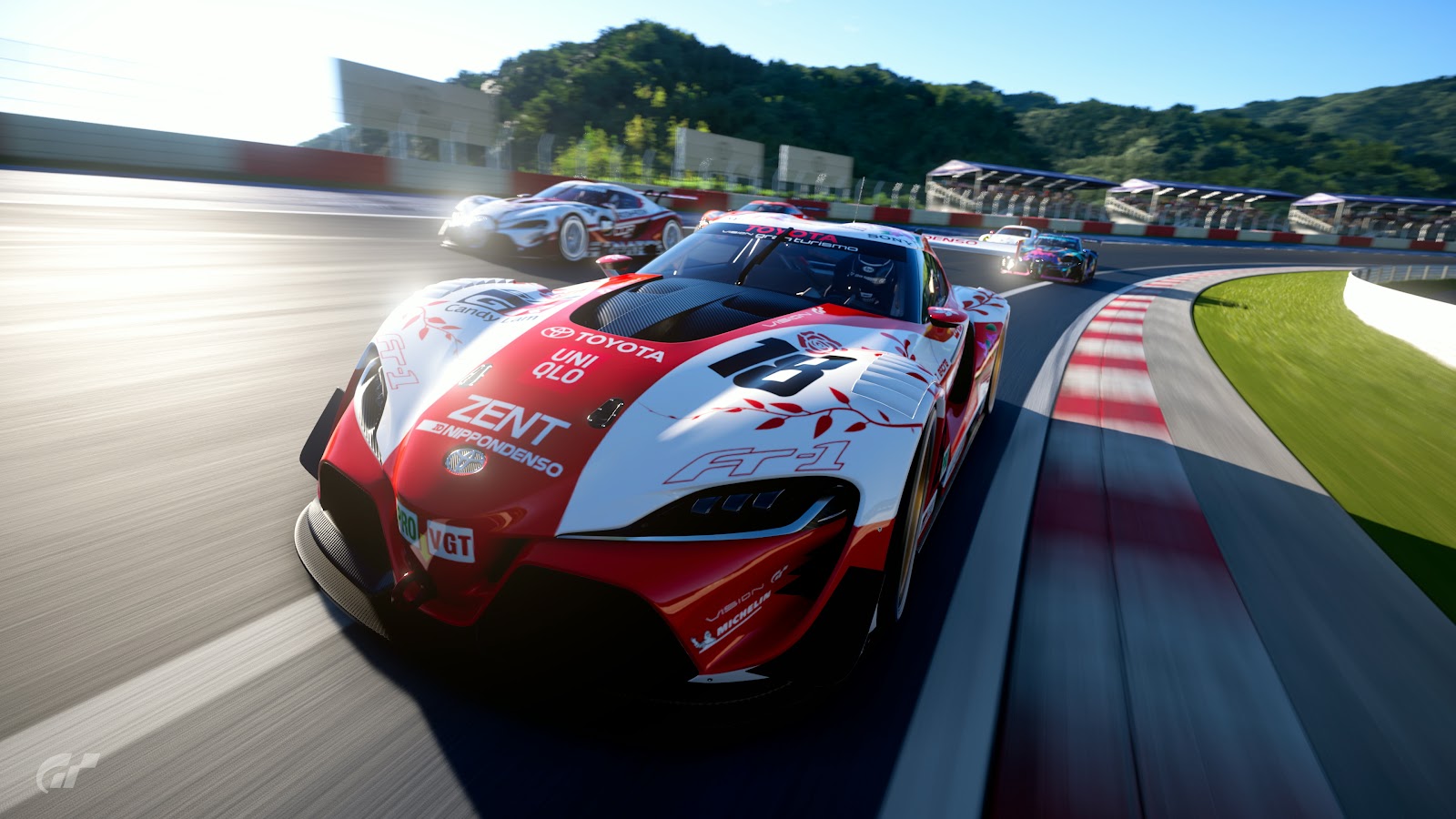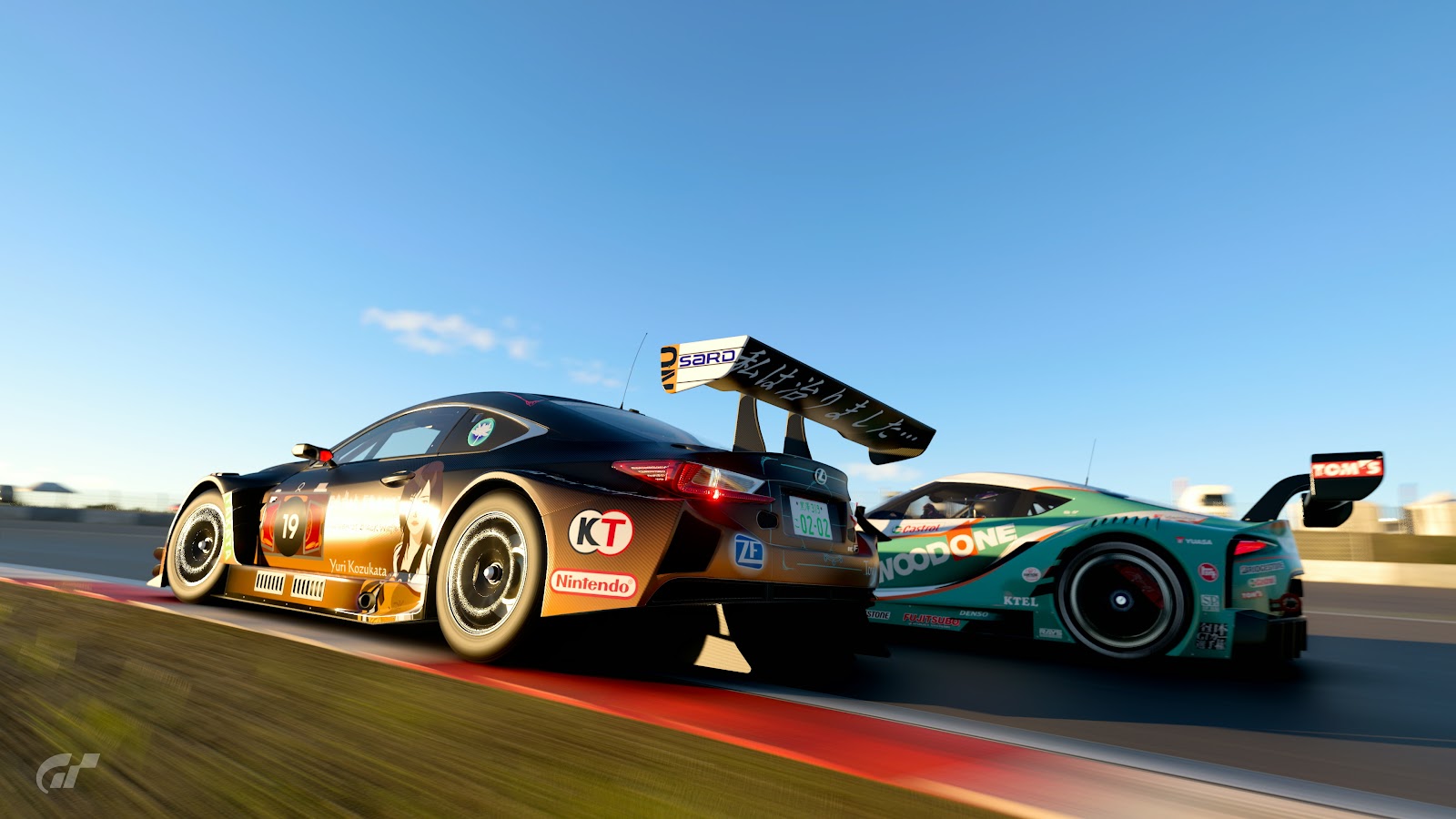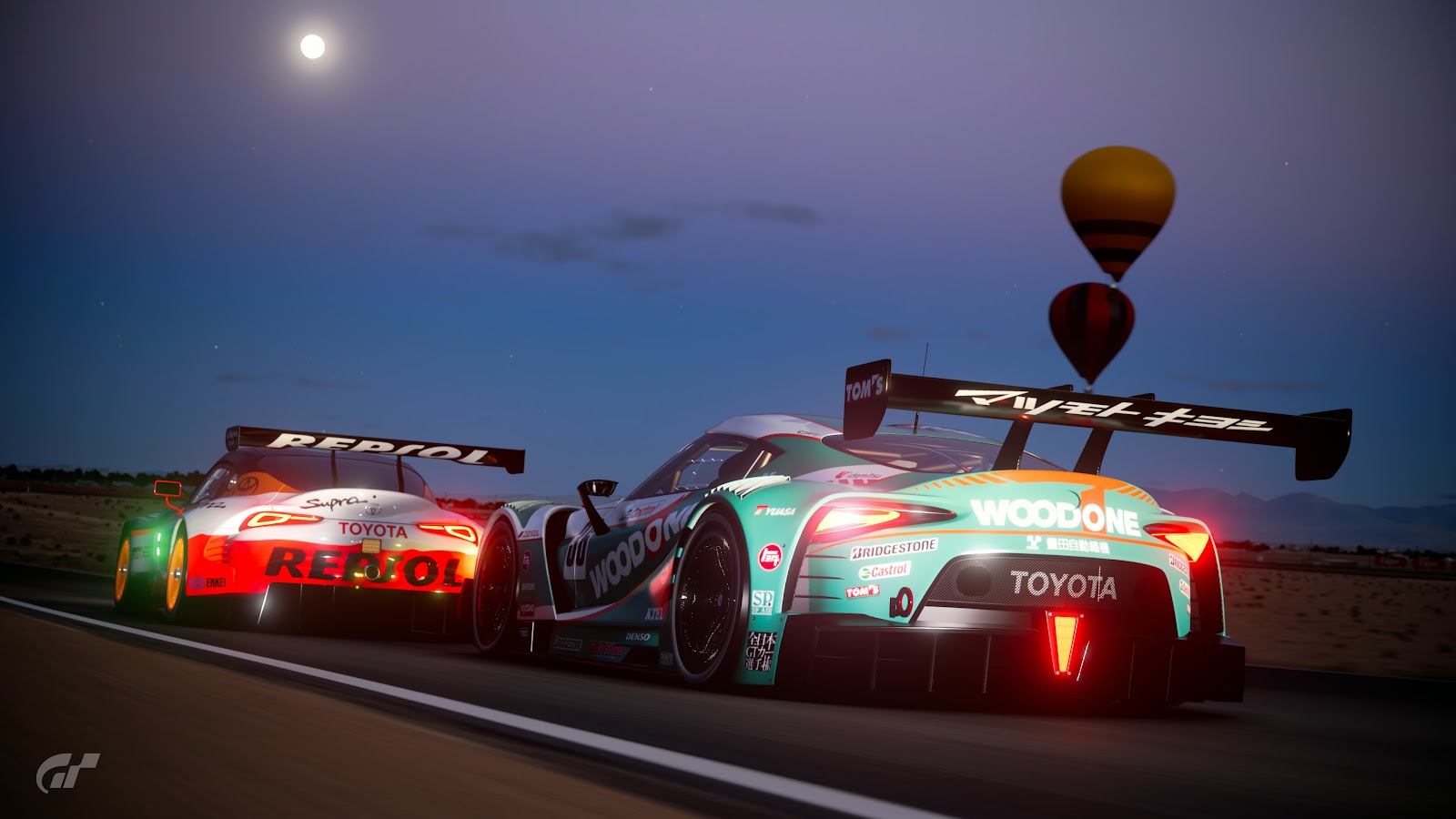The Toyota FT-1 VGT Gr.3 may explicitly have "Gr.3" in its name, but it feels to me like what you'd get if you took a GT500 car and hacked off a good chunk of its power and downforce. Predictably, it drives like a confused, bloody disaster as a result.
#pantyandstocking #psg# #itasha
But to understand why I assert that the FT-1 VGT is a GT500 car, we need to first take a quick skim through the FT-1's brief history, and make a few quick assumptions as to what Toyota were aiming to do with it.
Unveiled at the 2014 North American International Auto Show, the original FT-1 concept car served as the spark that facilitated the arson of excitement on the camp of people that had been sorely missing and eagerly awaiting the revival of the "Supra" namesake by Toyota. Despite flaunting a clear engine cover cutout on the car's risqué bonnet, what Toyota was envisioning bolting under that see–through space was a total mystery—both in real life where engine covers have oddly become the norm, and in Gran Turismo games where any hard numbers were simply not given to the players. Fortunately, the games did at least have to give the FT-1 a voice, and the voice that was bestowed upon the silhouette of the hopeful Future Toyota was that of a Inline 6, setting up the FT-1 to fall in line together with some of Toyota's most revered creations in the past like the 2000GT and the A80 Supra.
From this, the FT-1 was adopted into the contentious Vision Gran Turismo program, spawning a race–ready version of the FT-1 by first adding the "VGT" suffix to the name, then widening its body, slamming its ride height, bolting on full racing slicks and a towering rear wing, heavily gouging its body panels, and putting it all through an unhealthy diet, all to bring the specs of the car to what the Gran Turismo community derived to be 614HP and 1,000kg in mass (458kW, 2,200lbs). The Otaku among the car enthusiasts may already feel a tinge of nagging familiarity seeing those numbers, but the most telling number of them may just be the number "4"—the racing version of the FT-1, the FT-1 VGT, makes Inline 4 noises instead of those of an Inline 6, and it came with a KERS. 2014 was also the first year that GT500 technical regulations unified with DTM's, which stipulated that all cars are to be FR with 2 litre single turbo Inline 4 engines with KERS... weighing a tonne and outputting a little over 600HP.
If the original FT-1 was meant to preview the production Supra, then I think it's pretty clear that the FT-1 VGT was meant to preview Toyota's plans to represent themselves with a Supra in Super GT's GT500 category.
But, a production ready Supra wouldn't become reality until 2019, some two years after the launch of Gran Turismo Sport—a video game that laser focuses on sanctioned racing with "Gr.3" and "Gr.4" cars, loosely based on real life GT3 and GT4 categories respectively. A Gr.3 86 more than makes sense in my opinion, seeing as some privateer teams have already fielded 86s and BRZs in GT300, but I suppose it's much easier to simply take an existing model and lop some speed off than to make an entirely new car from the ground up, which is probably why the FT-1 VGT was kneecapped to squeeze into Gr.3 as Toyota's representation in the e–sports centric title—at least, until the "proper" Supra arrived. Power was slashed to 544HP (406kW), and the car would have to put back on some the mass that was so thoroughly shed to become a racecar—280 kilos of it, in fact, to fit into Gr.3 at a middling 1,280kg (2,822lbs). Other unseen changes include unplugging the KERS, while shortening and bringing closer together the largely useless ratios of the FT-1 VGT to make up for it.
It's almost like Polyphony Digital simply could not change a single node of how the car looked, out of respect or some licensing agreement—I can't say. Unfortunately, that also meant that they couldn't change the ride height of the FT-1 VGT, which snowballs into a few glaring issues with the car here in GT7.
For some context, most FR cars built from the ground up for Gr.3 come with a ride height of 60mm front and 70mm rear in GT7 (2.36in, 2.76in). The FT-1 VGT Gr.3 however, smothers its own shadow at a mere 50mm front and 60mm rear (1.97in, 2.36in). "But that's a good thing, right? Low cars go faster in corners, don't they?", you might be asking. As with most things, a low ride height is only good in moderation, and the FT-1 Gr.3 comes in way too low, even for a racing car.
With the car being set low enough to spark on some of the less obsessively smoothed over racetracks outside of Japan, the FT-1 Gr.3 is extremely sensitive to road imperfections, elevation changes, and just a nervous wreck to drive in any situation. Seemingly flat and innocuous rumble strips, such as the one on the inside of Suzuka's Turn 2, for instance, will quite literally and figuratively tilt the car, liable to result in a perpendicular meeting with the inside barrier if not caught immediately. That rumble strip, for all intents and purposes other than supporting an FT-1 VGT, is completely flat, even in bona fide GT500 machines and Super Formulae. With a car set so low, the suspension also has to be set that much more stiffer than most Gr.3 cars to prevent the car from completely bottoming out or shaving off its own body panels with its tyres, and what translates to in handlingese is that the car can't seem to put weight on any tyre at all; it takes a touch longer to slow for a corner than most Gr.3 cars, with or without BoP, nor does it much want to bite an apex with trail braking, even with a fully rearward brake bias setting. When getting on the power, I can't "load up" the rear tyres at all, no matter how gradually I ease into the throttle pedal; past three quarters throttle, the rear end just instantly snaps off if there's any steering lock applied. The car simply feels set up to have much more grip than any Gr.3 car can be allowed to have, mechanical and aerodynamic.
Now in the much more liberal Gr.3 category, the FT-1 VGT Gr.3 could have had either the Inline 6 of the original FT-1, or the Inline 4 of the FT-1 VGT. Thankfully, the Gr.3 car went with the latter, because I think it's one of the most flexible and pleasant engines I've ever sampled in both GT Sport and here in GT7! Power output may have been slashed, but the hyphen engine still revs to a Rotary–shaming, Hayabusa–harassing 10,500rpm! It might be a reasonable assumption to make that an engine that revs to such common sense defying speeds would be a small displacement engine, utterly gutless in the low and mid range. That may well be the case, but we will never know for certain because that's where the turbocharger comes in to save the day—it delivers its peak boost of almost 1 bar at around 5,2, past which the boost pressure completely deflates to let the engine's natural peakiness take over. What this combo results in is an engine that I never would have guessed is turbocharged if not for the spec sheets and in–game HUD; it's peppy, responsive, makes no turbo noises, still asks of its driver to rev it out to about 9,6, but has a healthy punch from around 7,5 to overwhelm the maladjusted suspension setup. For some context, most upshifts at 9,6 drop the engine to about 8,2, giving drivers a lot of leeway in where and when to shift. Sometimes I find myself flicking through the paddles just for the hell of it. 9,6, by the way, is also when the car will upshift if driven in AT mode, making this car an extremely inclusive and welcoming pick for players who can't, or don't want to shift for themselves. Drivers can even save an upshift when fast approaching a corner with a healthy 900rpm headroom between the optimum shift point of 9,6 to the engine's fuel cut at 10,5 if this engine ever becomes available to swap into a manual gearbox car, and it's a thought that I'm properly salivating over. I genuinely think this would be the perfect racing engine if it wasn't thirstier than the livery I put on the car!
To illustrate, I decided to compare the FT-1 VGT Gr.3 to the GT3 version of the car Toyota were looking to replace with the FT-Supra in GT500: the Lexus RC F GT3 '17. Straight from the Brand Central, the Lexus weighs more, has less power, is less balanced with 54% of its weight up front as opposed to the FT-1's 51%, and it doesn't have a purpose sculpted low and svelte sports car body to effortlessly slice through the air, instead having to wear the silhouette of a luxobarge. A car like that, no one would think has a chance in hell against the FT-1, but—get this—the hulking 5 Litre NA V8 of the RC F returned me much better fuel economy, all in spite of heaving around more mass, which let me clear the lucrative Sardegna WTC800 event faster. That, plus the Lexus was just a much more predictable drive. How can the FT-1 have all those numbers and still be this slow?!
https://youtu.be/uMv921H7BiY
Under BoP conditions in our lobby, the two cars are much more closely matched. The FT-1 seemingly still has some pace to match the midfielders, but it got utterly destroyed when matched up against a currently strong pick for Gr.3 in the Mazda RX-Vision GT3 Concept '20, with its only saving grace being Vic behind the wheel of the Toyota.
The RX-Vision GT3 is similarly a high revving, racing version of a long hood, short deck FR concept sports car from around 2014. While the shrieking RX-Vision similarly doesn't have the hot lap pace to compete against the current meta that is the Gr.3 Supra, it still has a strong presence in Gr.3 races nowadays, owing to its scrumptious looks and equally bewitching handling—traits the FT-1 Gr.3 used to boast back in GTS before the Supra replaced it. But, handling impeccably is just the RX-V's side hustle; it's main draw is that it's incredibly light on tyre wear and fuel use, making it a very quick car in races where pitting is involved. With its biggest strength being nullified in a short 4 lap sprint though, how does my RX-V fare against Vic's FT-1 around Big Willow?
https://youtu.be/IcluKRYEiXs
...insultingly well, actually. Races against Vic usually come with a rapidly impending sense of doom; "oh boy, Vic's in 2nd now, I hope I can hold onto this 3 second gap with 2 laps to g— HOW DID HE JUST TAKE HALF A SECOND OFF ME IN ONE CORNER OHMYGOD". In that race, though? Even with cautious driving within known limits as a result of fading FFB, I was gapping Vic's FT-1 consistently come the straights. Understand, the RX-V is not a straight line missile; it has longer ratios than the FT-1, and under v1.35 BoP when we ran this race, it also has a worse power to mass ratio! Yet, it gapped the FT-1 in the straights, simply because it can actually put down power out of corners. For the first time in perhaps ever, I felt a sense of reassurance and calm when being chased by Vic, simply because I knew I had a much, much better car.
The FT-1 VGT Gr.3 has gone to great lengths to fix the flaws of the original FT-1 VGT: it doesn't hide its specs or power curves, fixes its useless gearing, while offering upgrade potential via turbo kits and adjustability to its suspension setup, both of which completely unavailable in the original, all while coming in at less than half the price. And, sweet baby Buddha, have I mentioned how astounding this thing looks yet?! Its outlandish, free, and expressive design makes a A90 Supra look like a pale, castrated imitation of what ought to have been. Just like how a pretty girl can make even pajamas look pretty, the FT-1 makes just about any livery on it standout masterpieces. There wasn't a single "eh, that's pretty good" livery from my peers during race day; they were all bangers I'd love to rock, from Baron's badass skull design, Vic's adapted Woodone livery that looks like it had been designed for the FT-1 and borrowed to the A80 Supra instead of the other way around, to Candy Lam's patriotic Hong Kongese car. Had the production A90 Supra looked like this, revved like this, and drove well, I might finally feel again that indescribable magic feeling that the bubble era of Japanese sports cars made me feel.
While politics will understandably work against the FT-1 now that a fully fledged Supra race car is available in Gr.3, the only way an FT-1 can win hearts and eke out a niche for itself is via subjective fronts. Me personally, I really, really wanted to like this car, especially after I spent about four days obsessively making a livery for the car. I don't even care of it's slow; I just wish it drove better. I would happily take this car and punch up against the meta if it had the prowess and consistency to do so. Ask my peers how many times I brought my Cayman GT4CS to race in Car of the Week over the 3 or so years I've been doing this, knowing full well its shite and uncompetitive. If I can trust the car and know it well, I can push it much closer to its limits, making me faster than if I were in an unfamiliar meta car. What makes or breaks the appeal of of a handling car for me is that it should earn the driver's trust, and perhaps entice them to play just a little bit, even in the context of a racecar. None of the FT-1s made me feel that. And unlike the Genesis X GR3 of Week 13, there unfortunately is no quick, easy fix to the FT-1 Gr.3's problems, and so I find it very, very hard to like the car, and it breaks my goddamn heart that I can't fall for it.











No comments:
Post a Comment